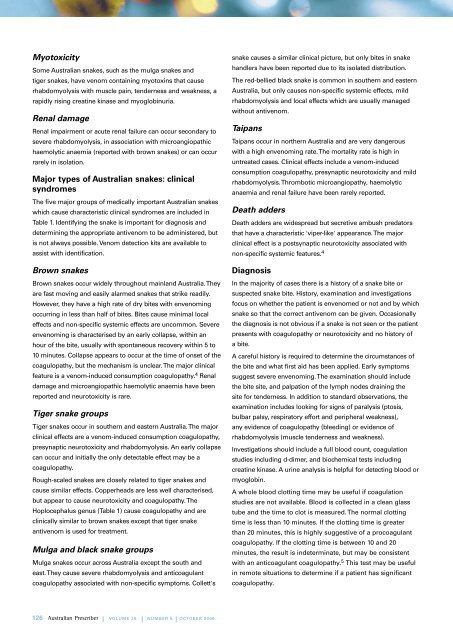download the full PDF issue - Australian Prescriber
download the full PDF issue - Australian Prescriber
download the full PDF issue - Australian Prescriber
Create successful ePaper yourself
Turn your PDF publications into a flip-book with our unique Google optimized e-Paper software.
Myotoxicity<br />
Some <strong>Australian</strong> snakes, such as <strong>the</strong> mulga snakes and<br />
tiger snakes, have venom containing myotoxins that cause<br />
rhabdomyolysis with muscle pain, tenderness and weakness, a<br />
rapidly rising creatine kinase and myoglobinuria.<br />
Renal damage<br />
Renal impairment or acute renal failure can occur secondary to<br />
severe rhabdomyolysis, in association with microangiopathic<br />
haemolytic anaemia (reported with brown snakes) or can occur<br />
rarely in isolation.<br />
Major types of <strong>Australian</strong> snakes: clinical<br />
syndromes<br />
The five major groups of medically important <strong>Australian</strong> snakes<br />
which cause characteristic clinical syndromes are included in<br />
Table 1. Identifying <strong>the</strong> snake is important for diagnosis and<br />
determining <strong>the</strong> appropriate antivenom to be administered, but<br />
is not always possible. Venom detection kits are available to<br />
assist with identification.<br />
Brown snakes<br />
Brown snakes occur widely throughout mainland Australia. They<br />
are fast moving and easily alarmed snakes that strike readily.<br />
However, <strong>the</strong>y have a high rate of dry bites with envenoming<br />
occurring in less than half of bites. Bites cause minimal local<br />
effects and non-specific systemic effects are uncommon. Severe<br />
envenoming is characterised by an early collapse, within an<br />
hour of <strong>the</strong> bite, usually with spontaneous recovery within 5 to<br />
10 minutes. Collapse appears to occur at <strong>the</strong> time of onset of <strong>the</strong><br />
coagulopathy, but <strong>the</strong> mechanism is unclear. The major clinical<br />
feature is a venom-induced consumption coagulopathy. 4 Renal<br />
damage and microangiopathic haemolytic anaemia have been<br />
reported and neurotoxicity is rare.<br />
Tiger snake groups<br />
Tiger snakes occur in sou<strong>the</strong>rn and eastern Australia. The major<br />
clinical effects are a venom-induced consumption coagulopathy,<br />
presynaptic neurotoxicity and rhabdomyolysis. An early collapse<br />
can occur and initially <strong>the</strong> only detectable effect may be a<br />
coagulopathy.<br />
Rough-scaled snakes are closely related to tiger snakes and<br />
cause similar effects. Copperheads are less well characterised,<br />
but appear to cause neurotoxicity and coagulopathy. The<br />
Hoplocephalus genus (Table 1) cause coagulopathy and are<br />
clinically similar to brown snakes except that tiger snake<br />
antivenom is used for treatment.<br />
Mulga and black snake groups<br />
Mulga snakes occur across Australia except <strong>the</strong> south and<br />
east. They cause severe rhabdomyolysis and anticoagulant<br />
coagulopathy associated with non-specific symptoms. Collett's<br />
126 | VOLUME 29 | NUMBER 5 | OCTOBER 2006<br />
snake causes a similar clinical picture, but only bites in snake<br />
handlers have been reported due to its isolated distribution.<br />
The red-bellied black snake is common in sou<strong>the</strong>rn and eastern<br />
Australia, but only causes non-specific systemic effects, mild<br />
rhabdomyolysis and local effects which are usually managed<br />
without antivenom.<br />
Taipans<br />
Taipans occur in nor<strong>the</strong>rn Australia and are very dangerous<br />
with a high envenoming rate. The mortality rate is high in<br />
untreated cases. Clinical effects include a venom-induced<br />
consumption coagulopathy, presynaptic neurotoxicity and mild<br />
rhabdomyolysis. Thrombotic microangiopathy, haemolytic<br />
anaemia and renal failure have been rarely reported.<br />
Death adders<br />
Death adders are widespread but secretive ambush predators<br />
that have a characteristic 'viper-like' appearance. The major<br />
clinical effect is a postsynaptic neurotoxicity associated with<br />
non-specific systemic features. 4<br />
Diagnosis<br />
In <strong>the</strong> majority of cases <strong>the</strong>re is a history of a snake bite or<br />
suspected snake bite. History, examination and investigations<br />
focus on whe<strong>the</strong>r <strong>the</strong> patient is envenomed or not and by which<br />
snake so that <strong>the</strong> correct antivenom can be given. Occasionally<br />
<strong>the</strong> diagnosis is not obvious if a snake is not seen or <strong>the</strong> patient<br />
presents with coagulopathy or neurotoxicity and no history of<br />
a bite.<br />
A careful history is required to determine <strong>the</strong> circumstances of<br />
<strong>the</strong> bite and what first aid has been applied. Early symptoms<br />
suggest severe envenoming. The examination should include<br />
<strong>the</strong> bite site, and palpation of <strong>the</strong> lymph nodes draining <strong>the</strong><br />
site for tenderness. In addition to standard observations, <strong>the</strong><br />
examination includes looking for signs of paralysis (ptosis,<br />
bulbar palsy, respiratory effort and peripheral weakness),<br />
any evidence of coagulopathy (bleeding) or evidence of<br />
rhabdomyolysis (muscle tenderness and weakness).<br />
Investigations should include a <strong>full</strong> blood count, coagulation<br />
studies including d-dimer, and biochemical tests including<br />
creatine kinase. A urine analysis is helpful for detecting blood or<br />
myoglobin.<br />
A whole blood clotting time may be useful if coagulation<br />
studies are not available. Blood is collected in a clean glass<br />
tube and <strong>the</strong> time to clot is measured. The normal clotting<br />
time is less than 10 minutes. If <strong>the</strong> clotting time is greater<br />
than 20 minutes, this is highly suggestive of a procoagulant<br />
coagulopathy. If <strong>the</strong> clotting time is between 10 and 20<br />
minutes, <strong>the</strong> result is indeterminate, but may be consistent<br />
with an anticoagulant coagulopathy. 5 This test may be useful<br />
in remote situations to determine if a patient has significant<br />
coagulopathy.

















